jump start OPEL GRANDLAND X 2018 Infotainment system
[x] Cancel search | Manufacturer: OPEL, Model Year: 2018, Model line: GRANDLAND X, Model: OPEL GRANDLAND X 2018Pages: 265, PDF Size: 7.5 MB
Page 140 of 265
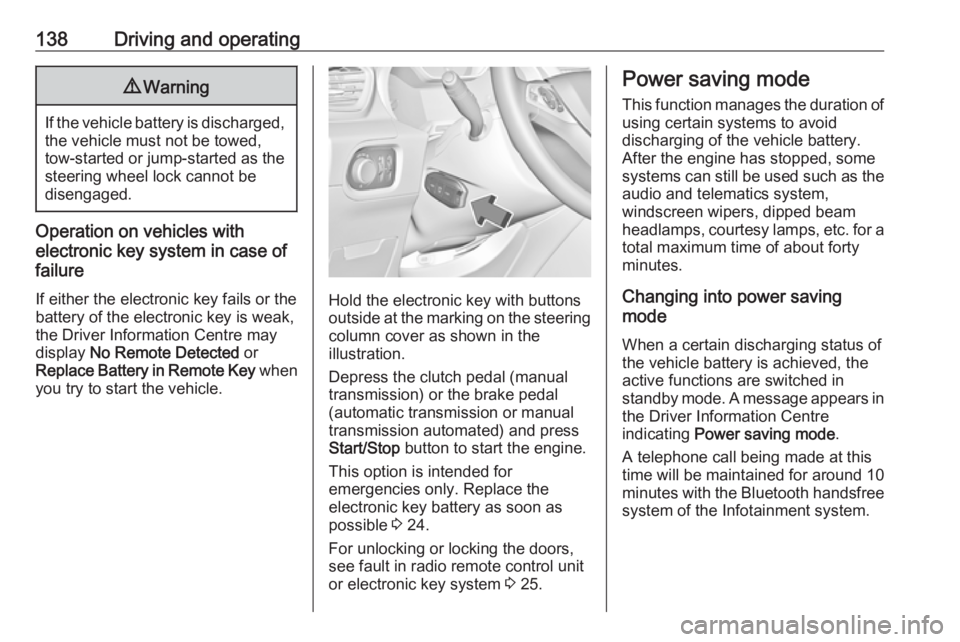
138Driving and operating9Warning
If the vehicle battery is discharged,
the vehicle must not be towed,
tow-started or jump-started as the
steering wheel lock cannot be
disengaged.
Operation on vehicles with
electronic key system in case of
failure
If either the electronic key fails or the
battery of the electronic key is weak,
the Driver Information Centre may
display No Remote Detected or
Replace Battery in Remote Key when
you try to start the vehicle.
Hold the electronic key with buttons outside at the marking on the steering column cover as shown in the
illustration.
Depress the clutch pedal (manual
transmission) or the brake pedal
(automatic transmission or manual
transmission automated) and press
Start/Stop button to start the engine.
This option is intended for
emergencies only. Replace the
electronic key battery as soon as
possible 3 24.
For unlocking or locking the doors,
see fault in radio remote control unit
or electronic key system 3 25.
Power saving mode
This function manages the duration of
using certain systems to avoid
discharging of the vehicle battery.
After the engine has stopped, some
systems can still be used such as the audio and telematics system,
windscreen wipers, dipped beam
headlamps, courtesy lamps, etc. for a total maximum time of about forty
minutes.
Changing into power saving
mode
When a certain discharging status of
the vehicle battery is achieved, the
active functions are switched in
standby mode. A message appears in the Driver Information Centre
indicating Power saving mode .
A telephone call being made at this
time will be maintained for around 10
minutes with the Bluetooth handsfree
system of the Infotainment system.
Page 153 of 265
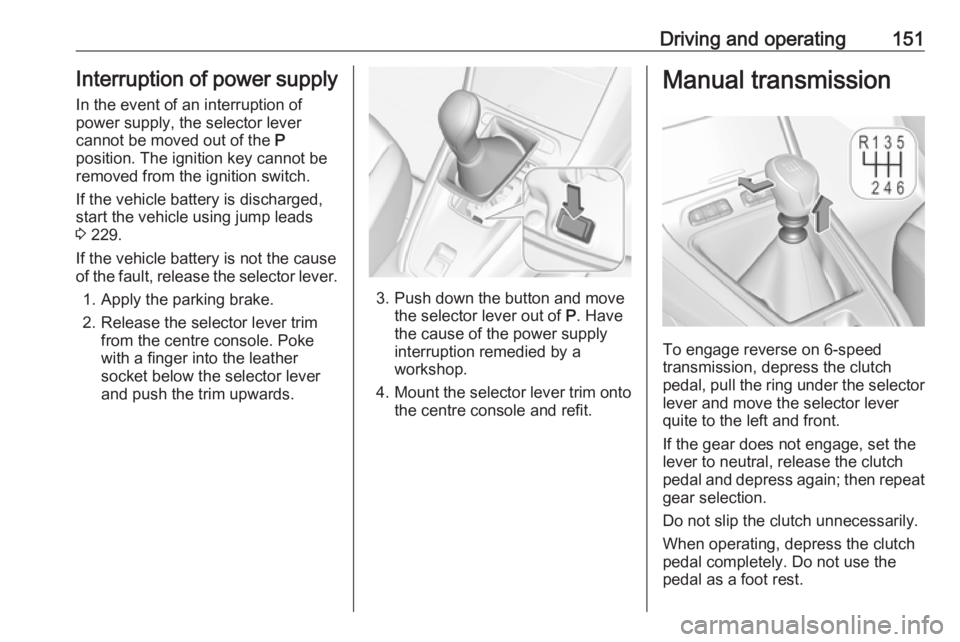
Driving and operating151Interruption of power supplyIn the event of an interruption of
power supply, the selector lever
cannot be moved out of the P
position. The ignition key cannot be
removed from the ignition switch.
If the vehicle battery is discharged,
start the vehicle using jump leads
3 229.
If the vehicle battery is not the cause
of the fault, release the selector lever.
1. Apply the parking brake.
2. Release the selector lever trim from the centre console. Poke
with a finger into the leather
socket below the selector lever
and push the trim upwards.
3. Push down the button and move the selector lever out of P. Have
the cause of the power supply interruption remedied by a
workshop.
4. Mount the selector lever trim onto
the centre console and refit.
Manual transmission
To engage reverse on 6-speed
transmission, depress the clutch
pedal, pull the ring under the selector
lever and move the selector lever
quite to the left and front.
If the gear does not engage, set the
lever to neutral, release the clutch
pedal and depress again; then repeat gear selection.
Do not slip the clutch unnecessarily. When operating, depress the clutchpedal completely. Do not use the
pedal as a foot rest.
Page 205 of 265
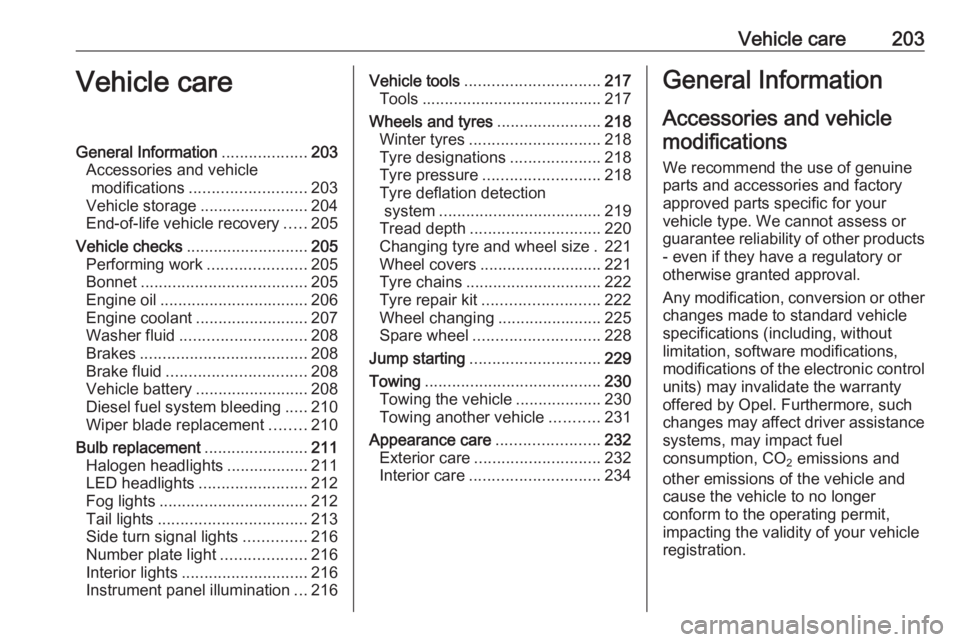
Vehicle care203Vehicle careGeneral Information...................203
Accessories and vehicle modifications .......................... 203
Vehicle storage ........................204
End-of-life vehicle recovery .....205
Vehicle checks ........................... 205
Performing work ......................205
Bonnet ..................................... 205
Engine oil ................................. 206
Engine coolant ......................... 207
Washer fluid ............................ 208
Brakes ..................................... 208
Brake fluid ............................... 208
Vehicle battery ......................... 208
Diesel fuel system bleeding .....210
Wiper blade replacement ........210
Bulb replacement .......................211
Halogen headlights ..................211
LED headlights ........................ 212
Fog lights ................................. 212
Tail lights ................................. 213
Side turn signal lights ..............216
Number plate light ...................216
Interior lights ............................ 216
Instrument panel illumination ...216Vehicle tools .............................. 217
Tools ........................................ 217
Wheels and tyres .......................218
Winter tyres ............................. 218
Tyre designations ....................218
Tyre pressure .......................... 218
Tyre deflation detection system .................................... 219
Tread depth ............................. 220
Changing tyre and wheel size . 221
Wheel covers ........................... 221
Tyre chains .............................. 222
Tyre repair kit .......................... 222
Wheel changing .......................225
Spare wheel ............................ 228
Jump starting ............................. 229
Towing ....................................... 230
Towing the vehicle ...................230
Towing another vehicle ...........231
Appearance care .......................232
Exterior care ............................ 232
Interior care ............................. 234General Information
Accessories and vehicle modifications
We recommend the use of genuine
parts and accessories and factory
approved parts specific for your
vehicle type. We cannot assess or guarantee reliability of other products - even if they have a regulatory or
otherwise granted approval.
Any modification, conversion or other
changes made to standard vehicle
specifications (including, without
limitation, software modifications,
modifications of the electronic control units) may invalidate the warranty
offered by Opel. Furthermore, such
changes may affect driver assistance
systems, may impact fuel
consumption, CO 2 emissions and
other emissions of the vehicle and
cause the vehicle to no longer
conform to the operating permit,
impacting the validity of your vehicle
registration.
Page 211 of 265
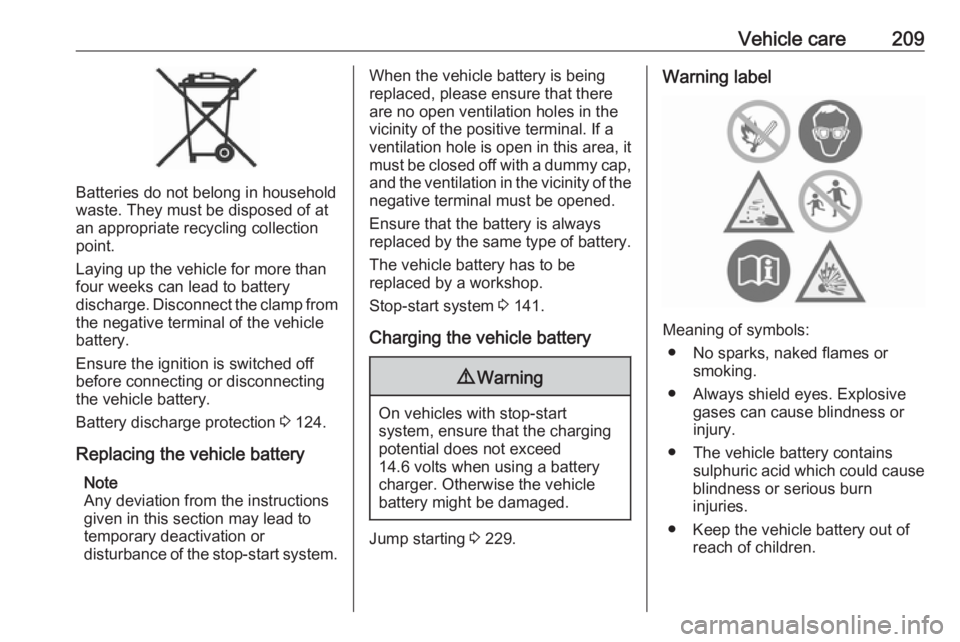
Vehicle care209
Batteries do not belong in household
waste. They must be disposed of at
an appropriate recycling collection
point.
Laying up the vehicle for more than
four weeks can lead to battery
discharge. Disconnect the clamp from the negative terminal of the vehicle
battery.
Ensure the ignition is switched off
before connecting or disconnecting
the vehicle battery.
Battery discharge protection 3 124.
Replacing the vehicle battery Note
Any deviation from the instructions
given in this section may lead to
temporary deactivation or
disturbance of the stop-start system.
When the vehicle battery is being
replaced, please ensure that there
are no open ventilation holes in the
vicinity of the positive terminal. If a
ventilation hole is open in this area, it
must be closed off with a dummy cap, and the ventilation in the vicinity of the negative terminal must be opened.
Ensure that the battery is always
replaced by the same type of battery.
The vehicle battery has to be
replaced by a workshop.
Stop-start system 3 141.
Charging the vehicle battery9 Warning
On vehicles with stop-start
system, ensure that the charging potential does not exceed
14.6 volts when using a battery
charger. Otherwise the vehicle
battery might be damaged.
Jump starting 3 229.
Warning label
Meaning of symbols:
● No sparks, naked flames or smoking.
● Always shield eyes. Explosive gases can cause blindness or
injury.
● The vehicle battery contains sulphuric acid which could cause
blindness or serious burn
injuries.
● Keep the vehicle battery out of reach of children.
Page 231 of 265

Vehicle care229
1.Remove centre cap with the brand
emblem by pushing from the
inside.
2. Position the wheel outside down in the wheel well.
3. Secure the defective wheel with the wing nut.
4. Depending on the tyre size, the floor cover can be placed on the
projecting wheel.
Jump starting
Do not start with quick charger.
A vehicle with a discharged vehicle
battery can be started using jump
leads and the vehicle battery of
another vehicle.9 Warning
Be extremely careful when starting
with jump leads. Any deviation
from the following instructions can
lead to injuries or damage caused
by battery explosion or damage to the electrical systems of both
vehicles.
9 Warning
Avoid contact of the battery with
eyes, skin, fabrics and painted
surfaces. The fluid contains
sulphuric acid which can cause
injuries and damage in the event
of direct contact.
● Never expose the vehicle battery
to naked flames or sparks.
● A discharged vehicle battery can already freeze at a temperature
of 0 °C. Defrost the frozen battery before connecting jump leads.
● Wear eye protection and protective clothing when
handling a battery.
● Use a booster battery with the same voltage (12 Volts). Its
capacity (Ah) must not be much less than that of the discharged
vehicle battery.
● Use jump leads with insulated terminals and a cross section of
at least 16 mm 2
(25 mm 2
for
diesel engines).
● Do not disconnect the discharged
vehicle battery from the vehicle.
● Switch off all unnecessary electrical consumers.
● Do not lean over the vehicle battery during jump starting.
● Do not allow the terminals of one
lead to touch those of the other
lead.
Page 232 of 265
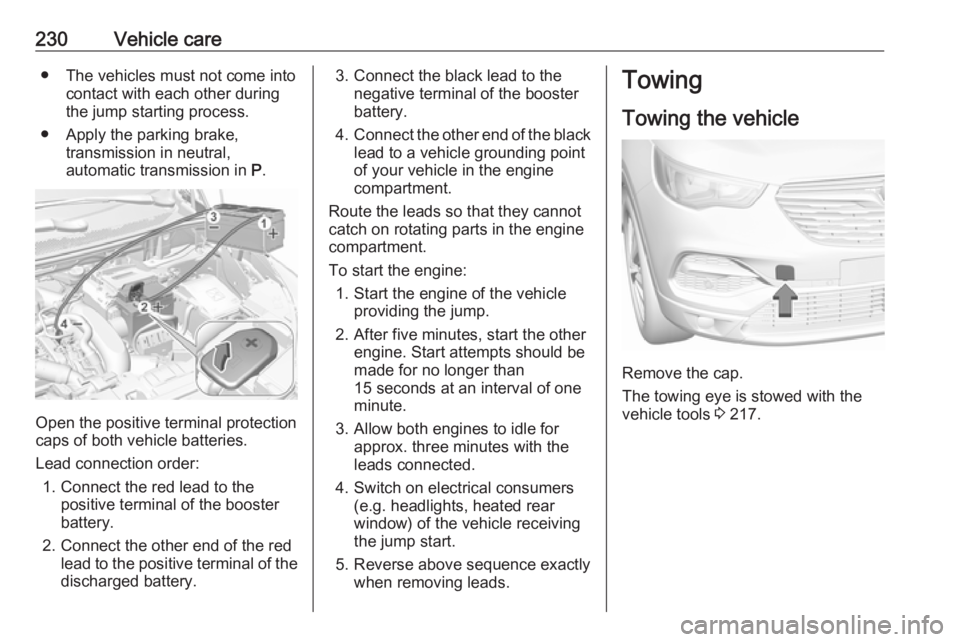
230Vehicle care● The vehicles must not come intocontact with each other during
the jump starting process.
● Apply the parking brake, transmission in neutral,
automatic transmission in P.
Open the positive terminal protection
caps of both vehicle batteries.
Lead connection order: 1. Connect the red lead to the positive terminal of the booster
battery.
2. Connect the other end of the red lead to the positive terminal of the
discharged battery.
3. Connect the black lead to the negative terminal of the boosterbattery.
4. Connect the other end of the black
lead to a vehicle grounding point
of your vehicle in the engine
compartment.
Route the leads so that they cannot
catch on rotating parts in the engine
compartment.
To start the engine: 1. Start the engine of the vehicle providing the jump.
2. After five minutes, start the other engine. Start attempts should be
made for no longer than
15 seconds at an interval of one
minute.
3. Allow both engines to idle for approx. three minutes with the
leads connected.
4. Switch on electrical consumers (e.g. headlights, heated rear
window) of the vehicle receiving
the jump start.
5. Reverse above sequence exactly when removing leads.Towing
Towing the vehicle
Remove the cap.
The towing eye is stowed with the
vehicle tools 3 217.
Page 262 of 265
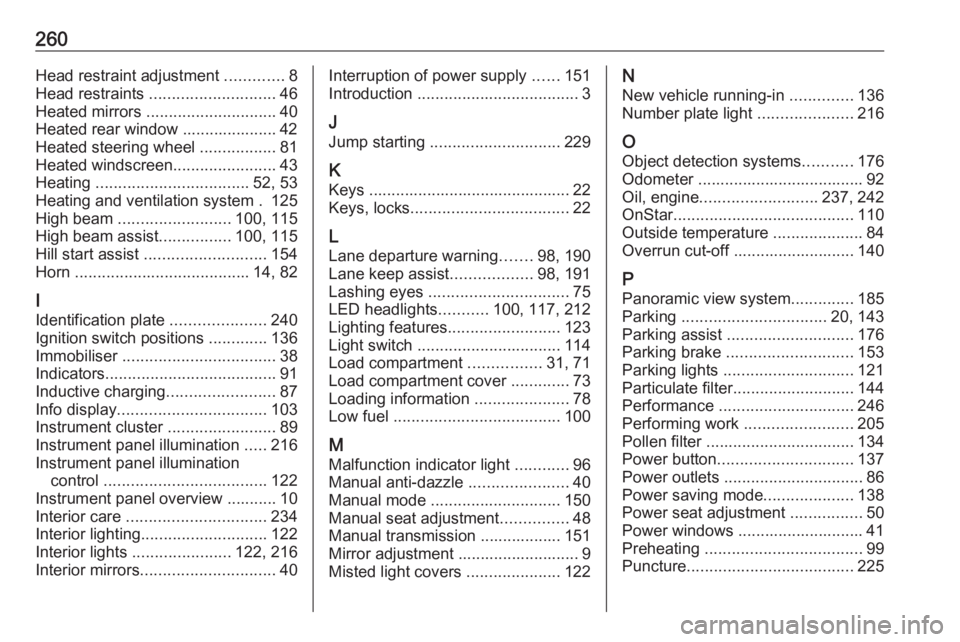
260Head restraint adjustment .............8
Head restraints ............................ 46
Heated mirrors ............................. 40
Heated rear window ..................... 42
Heated steering wheel .................81
Heated windscreen .......................43
Heating .................................. 52, 53
Heating and ventilation system . 125
High beam ......................... 100, 115
High beam assist ................100, 115
Hill start assist ........................... 154
Horn ....................................... 14, 82
I Identification plate .....................240
Ignition switch positions .............136
Immobiliser .................................. 38
Indicators ...................................... 91
Inductive charging ........................87
Info display ................................. 103
Instrument cluster ........................89
Instrument panel illumination .....216
Instrument panel illumination control .................................... 122
Instrument panel overview ........... 10
Interior care ............................... 234
Interior lighting ............................ 122
Interior lights ...................... 122, 216
Interior mirrors .............................. 40Interruption of power supply ......151
Introduction .................................... 3
J Jump starting ............................. 229
K Keys ............................................. 22
Keys, locks ................................... 22
L Lane departure warning .......98, 190
Lane keep assist ..................98, 191
Lashing eyes ............................... 75
LED headlights ...........100, 117, 212
Lighting features .........................123
Light switch ................................ 114
Load compartment ................31, 71
Load compartment cover .............73
Loading information .....................78
Low fuel ..................................... 100
M
Malfunction indicator light ............96
Manual anti-dazzle ......................40
Manual mode ............................. 150
Manual seat adjustment ...............48
Manual transmission .................. 151
Mirror adjustment ........................... 9
Misted light covers .....................122N
New vehicle running-in ..............136
Number plate light .....................216
O Object detection systems ...........176
Odometer ..................................... 92
Oil, engine .......................... 237, 242
OnStar ........................................ 110
Outside temperature ....................84
Overrun cut-off ........................... 140
P
Panoramic view system ..............185
Parking ................................ 20, 143
Parking assist ............................ 176
Parking brake ............................ 153
Parking lights ............................. 121
Particulate filter ........................... 144
Performance .............................. 246
Performing work ........................205
Pollen filter ................................. 134
Power button .............................. 137
Power outlets ............................... 86
Power saving mode ....................138
Power seat adjustment ................50
Power windows ............................ 41
Preheating ................................... 99
Puncture ..................................... 225